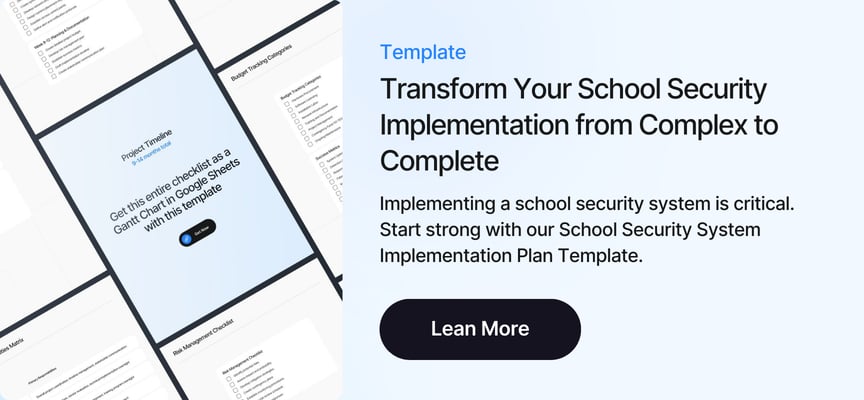What are ESSR funds?
ESSER (Elementary and Secondary School Emergency Relief) funds are federal grants provided to schools to address various needs, including critical safety and security improvements. They were allocated through three separate funding streams totaling nearly $190 billion, with many schools still having access to ESSER III funds that can be spent through January 2025 or later in states with approved extensions.
As school administrators face the ongoing challenge of enhancing campus safety while managing limited budgets, ESSER (Elementary and Secondary School Emergency Relief) funds present a valuable opportunity to invest in modern security solutions.
Understanding how to access and utilize these funds for security technology can help create safer learning environments without straining existing resources.
Understanding ESSER Funds for School Security
The Elementary and Secondary School Emergency Relief Fund provides significant support for schools to address various needs, including critical safety and security improvements. Here's what administrators need to know about using these funds for security technology.

Available ESSER Funding Streams
Three separate ESSER funding allocations have been made available to schools, each with specific guidelines and deadlines:
- ESSER I (CARES Act): $13.2 billion
- ESSER II (CRRSA Act): $54.3 billion
- ESSER III (ARP Act): $122.7 billion
While the initial obligation deadline for ESSER III funds was September 30, 2024, the U.S. Department of Education has approved extensions for several states through March 2026.
Schools in Delaware, Kansas, Kentucky, Nebraska, and Puerto Rico now have additional time to utilize approximately $1 billion in ESSER-ARP funding. Even for schools without extensions, funds that were properly obligated by September 30, 2024 can continue to be liquidated (spent) through January 28, 2025.
Qualifying Security Technology Expenses
ESSER funds can support various security-related investments that enhance school safety. Common qualifying expenses include:
- AI-powered video surveillance systems: Advanced technology that monitors campus activity 24/7, automatically detecting and alerting staff to potential security concerns in real-time
- Emergency notification systems: Integrated communication platforms that instantly alert relevant staff, first responders, and stakeholders during critical situations
- Access control solutions: Digital systems that manage and monitor entry points throughout campus, ensuring only authorized individuals can access specific areas
- Security monitoring equipment: Components like cameras and sensors that provide comprehensive visibility across campus facilities
- Integration of existing security infrastructure: Solutions that enhance current security investments by connecting and upgrading existing systems rather than replacing them
These investments align with ESSER's goal of creating safer, more secure learning environments.
GET THE TEMPLATE: Download our School Security System Implementation Plan Template
Making the Case for Security Technology
When applying for ESSER funds, it's crucial to demonstrate how security technology investments support student safety and learning outcomes. Here's how to build a compelling case.
Connecting Security to Student Success
Research shows that students learn better when they feel safe. Modern security technology contributes to this in several ways:
- Creates a more secure learning environment: Modern security technology provides comprehensive monitoring and rapid response capabilities that help maintain a safe, positive atmosphere for learning
- Enables faster response to emergencies: Real-time detection and notification systems allow staff to address situations immediately, often before they escalate
- Reduces disruptions to education: Proactive security measures help prevent incidents that could interrupt the learning process
- Provides peace of mind for students and staff: Knowing that advanced security systems are actively monitoring campus allows everyone to focus on their primary responsibilities
- Allows staff to focus on education rather than security concerns: Automated monitoring and alerts free up staff time that would otherwise be spent on manual security checks
These benefits directly support ESSER's core mission of enhancing educational outcomes.

Demonstrating Long-term Value
Modern security solutions offer sustainable benefits that extend beyond the funding period:
- Reduced ongoing security staffing costs: AI-powered systems can monitor multiple areas simultaneously, optimizing the deployment of security personnel
- Lower insurance premiums: Many insurance providers offer reduced rates for schools that implement advanced security technologies
- Decreased incident investigation time: Digital systems provide instant access to recorded events and automated reporting, dramatically reducing the time needed to review incidents
- Improved emergency response capabilities: Real-time monitoring and automated alerts enable faster, more coordinated responses to security situations
- Enhanced overall campus safety: Comprehensive security solutions create multiple layers of protection while maintaining an open, welcoming learning environment
These long-term advantages help justify the initial investment of ESSER funds.
Steps to Secure ESSER Funding for Security Technology
Successfully obtaining ESSER funds for security improvements requires careful planning and execution. Follow these key steps to strengthen your application.
Assessment and Planning
Before submitting your ESSER funding request, it's crucial to develop a comprehensive understanding of your school's security landscape and specific needs.
A thorough assessment not only strengthens your funding application but also ensures that any security investments will address your most pressing safety challenges effectively.
Begin with a thorough evaluation of your current security needs:
- Conduct a comprehensive security audit
- Identify specific vulnerabilities and gaps
- Document incident response times and safety concerns
- Gather feedback from staff, students, and parents
- Research available security solutions
This groundwork helps build a strong foundation for your funding request.

Read the Complete Guide: The Future of School Security in the Modern Era
Read the Complete Guide: The Future of School Security in the Modern EApplication ProcessSuccessfully securing ESSER funds for security improvements requires careful attention to detail and a clear demonstration of how these investments will enhance student safety and learning outcomes.
A well-structured application that clearly connects security improvements to educational goals has the best chance of approval. Follow these steps to submit a successful ESSER funding request:
- Review your state's specific ESSER guidelines
- Document how security technology addresses identified needs
- Prepare a detailed budget and implementation timeline
- Include metrics for measuring success
- Submit through appropriate channels
Clear documentation and alignment with ESSER objectives strengthen your application.
Maximizing ESSER Funds with AI-Powered Security
Modern AI-powered security solutions offer schools a way to maximize their ESSER investment by providing comprehensive protection that goes beyond traditional security measures. These systems can:
- Monitor multiple areas simultaneously
- Detect potential threats in real-time
- Reduce response times to incidents
- Provide detailed security insights
- Integrate with existing camera infrastructure
This technology helps schools create safer environments while optimizing their security resources.
Read the Case Study: How a Public High School Transformed School Security
Understanding ESSER Timeline and Future Funding
While ESSER represents unprecedented federal support for schools, it's important to understand both current availability and future funding considerations. Districts need to plan strategically for both immediate and long-term security needs.
Current Funding Status
Understanding the current state of ESSER funding is critical for making timely decisions about security investments.
While some deadlines have passed, opportunities still exist for schools to access and utilize these funds, particularly in states that have received extensions. Here's the current landscape of ESSER funding availability:
- ESSER I and II funds have reached their initial obligation deadlines
- ESSER III/ARP funds properly obligated by September 30, 2024 can be spent through January 28, 2025
- Selected states have received extensions through March 2026
- Future funding will need to come from local, state, and regular federal appropriations
Visit the full school security system funding resource center.
Applying for ESSER Extensions
Schools looking to extend their ESSER funding availability should work through their state education agencies, as extensions are granted at the state level rather than to individual districts. Here's how to pursue an extension:
- Contact your state education agency immediately to determine if your state qualifies
- Document specific circumstances preventing timely obligation of funds
- Prepare detailed plans for how extended funding would be used
- Demonstrate how the extension supports ongoing student needs
- Submit extension requests through proper state channels
The U.S. Department of Education evaluates extension requests based on "specific facts and circumstances," so strong documentation of need is essential. Currently, extensions have been granted to schools in Delaware, Kansas, Kentucky, Nebraska, and Puerto Rico, allowing continued access to funds through March 2026.
Next Steps for Administrators
As you consider using remaining ESSER funds for security improvements, keep these key points in mind:
- Review current ESSER fund availability and deadlines
- Assess your school's specific security needs
- Research qualifying security solutions
- Prepare necessary documentation
- Consult with security technology providers about implementation
Taking action now ensures you don't miss the opportunity to enhance your school's safety infrastructure with available federal funding.
Remember, investing in modern security technology isn't just about meeting immediate safety needs—it's about creating a lasting foundation for a secure learning environment where students can thrive.
Ready to learn more about maximizing your ESSER funds with AI-powered security? Contact VOLT AI for a consultation on how we can help enhance your school's safety infrastructure while making the most of available federal funding.




